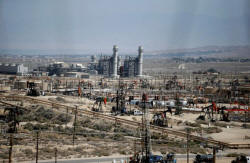U.S. to overtake Russia as top oil producer by 2019 at
latest: IEA
 Send a link to a friend
Send a link to a friend
 [February 27, 2018]
By Osamu Tsukimori [February 27, 2018]
By Osamu Tsukimori
TOKYO (Reuters) - The United States will
overtake Russia as the world's biggest oil producer by 2019 at the
latest, the International Energy Agency (IEA) said on Tuesday, as the
country's shale oil boom continues to upend global markets.
IEA Executive Director Fatih Birol said at an event in Tokyo the United
States would overtake Russia as the biggest crude oil producer
"definitely next year", if not this year.
"U.S. shale growth is very strong, the pace is very strong ... The
United States will become the No.1 oil producer sometime very soon," he
told Reuters separately.
U.S. crude oil output <C-OUT-T-EIA> rose above 10 million barrels per
day (bpd) late last year for the first time since the 1970s, overtaking
top oil exporter Saudi Arabia <PRODN-SA>.
The U.S. Energy Information Administration said early this month that
U.S. output would exceed 11 million bpd by late 2018. That would take it
past top producer Russia, which pumps just below that mark <C-RU-OUT>.

Birol said he did not see U.S. oil production peaking before 2020, and
that he did not expect a decline in the next four to five years.
The soaring U.S. production is upending global oil markets, coming at a
time when other major producers - including Russia and members of the
Middle East-dominated Organization of the Petroleum Exporting Countries
(OPEC) - have been withholding output to prop up prices <LCOc1>.
[to top of second column] |

Pump jacks are seen near vast Monterey shale formation in the Midway
Sunset oilfield, California, U.S. on April 29, 2013. REUTERS/Lucy
Nicholson/File Photo

U.S. oil is also increasingly being exported, including to the world's biggest
and fastest growing markets in Asia, eating away at OPEC and Russian market
share.
Meanwhile, U.S. net imports of crude oil fell last week by 1.6 million bpd to
4.98 million bpd, the lowest level since the EIA started recording the data in
2001, reflecting further erosion in a market OPEC has been relying on for
decades.
Birol said production growth was not just strong in the United States.
"Canada, especially the oil sands, and Brazilian offshore projects. These are
the two major (non-U.S.) drivers," he said.
On the demand side, Birol said the IEA expected growth of around 1.4 million bpd
in 2018.
GRAPHIC: http://reut.rs/2EIuTWS
GRAPHIC: http://tmsnrt.rs/2EtJgen
(Reporting by Osamu Tsukimori; Writing by Henning Gloystein; Editing by Tom
Hogue)
[© 2018 Thomson Reuters. All rights
reserved.] Copyright 2018 Reuters. All rights reserved. This material may not be published,
broadcast, rewritten or redistributed.
Thompson Reuters is solely responsible for this content. |